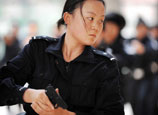
SYDNEY, May 23 (Xinhua) -- A research commissioned by Diversity Council Australia (DCA) suggests that Australian businesses in particular are failing to recognize and employ older women defined as 45 years and over.
The report shows that employing older women can provide businesses with experience, skills and talents. It shows how under utilized older women are in the workforce and what employers can do to harness their talents.
Older women constitute 17 percent of the Australian workforce with 45 percent of women over 45 in the labor force.
This compares to less than 25 percent in 1978. However, the participation level is substantially lower in all age groups compared to men, while the underemployment rate for women over 45 is 6.5 percent, compared to 4.7 percent for men of the same age.
Australia also trails many countries when it comes to employing older women. In the 55-64 age group, Australia is behind Sweden, New Zealand, the United States, Canada, Iceland, Norway, Estonia, Switzerland, Germany, Denmark and Finland.
Age Discrimination Commissioner, Hon Susan Ryan AO, said Australia is ignoring a huge pool of talent and experience by not employing older women and/or utilizing their talents and skills.
"This is a terrible waste of human capital that undermines the national imperative of growing the economy and results in significant loss to businesses. It also impacts the financial, emotional and physical wellbeing of the many women who are consigned to unwanted early retirement," Ryan said.
The research comes as Australians are working later in life, a trend predicted to continue into the future, according to new data analyzed by demographer Professor Peter McDonald from the Australian National University (ANU).
Professor McDonald compared results from the 2006 and 2011 Censuses of Australia to examine the changes in employment rates for people aged 55 years and older. He looked at a number of characteristics including marital status, education level, housing status, location and English level.
Age discrimination has been widely reported among Australian jobseekers, with 300,000 older Australians feeling unfairly judged.
Melbourne based Researcher Dr Roger Wilkins said about 480,000 workers suspected their employers had discriminated against them within the past two years because of their age.
"Many Australians feel they've been treated unfairly in the workplace," he said. "Age discrimination is the most common experience, which perhaps shouldn't be surprising given Australia' s ageing population." He said.
Professor McDonald blamed social changes, rather than policy intervention, for the shift in later-life employment. "The labor force is moving away from more manual labor to non-manual labor. People are starting work later in life, so they are retiring later. People are also having children later, so often they hit 60 and they are still supporting their kids," he said. "In the past older Australians had been happy with owning their own house and getting the age pension, but I think the next generation wants more than that. This is brought about by the superannuation revolution and that there is a chance of getting more than the age pension." In the late 1990's Professor McDonald forecast that Australia' s labor force participation rates at older ages would increase, and given the most recent increases, concluding that the Australian population is shifting in a direction that will lead to higher employment rates in the future.
Professor McDonald said Australia's resource-driven economy and the labor market in particular was benefitting from intensening trade with China. "The strength of the labor market itself is also driving this. Unemployment is low and economic growth has been high, so people who want to stay working have usually been able to do so."
Professor McDonald's research shows a 6 percentage point rise in the employment rate of men aged 55-59 years and a 7 percent rise for men aged 60-64 years from 2006 to 2011. Men aged 65-69 and 70-74 years also increased by about 5 percentage points each.
Females experienced the highest spikes, with more than a 10 percentage point jump in the employment rate for women between the ages of 55 and 64. The rise also continued for women aged 65-69, increasing by 6 percentage points in the six year period.
Chief executive of DCA Nareen Young said there is a strong business case for employing older women.
"Australia's future workforce will depend heavily on the employment of older women so this is not about special treatment for another group. Organizations focusing on older women's employment are future-proofing their workforce and positioning their organization for success.
















 Post office demolished by 'mistake' overnight
Post office demolished by 'mistake' overnight


![]()
